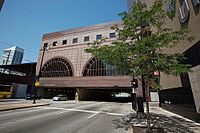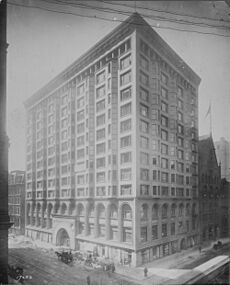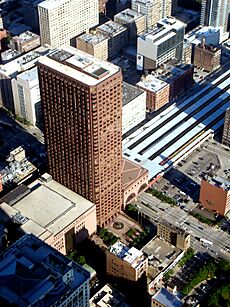Chicago Stock Exchange facts for kids
| Chicago Stock Exchange | |
|---|---|
Quick facts for kids  |
|
| Type | |
| Location | Chicago, Illinois, United States |
| Coordinates | 41°52′33″N 87°37′55″W / 41.87583°N 87.63194°W |
| Founded | March 21, 1882 |
| Currency | USD |
The Chicago Stock Exchange (CHX), also known as NYSE Chicago in its later years, was a place where people bought and sold stocks and bonds in Chicago, Illinois, US. It started in 1882. This exchange was a national market for buying and selling securities. It was watched over by the U.S. Securities and Exchange Commission (SEC), which makes sure markets are fair.
Intercontinental Exchange (ICE) bought CHX in July 2018. The exchange then changed its name to NYSE Chicago in February 2019. Under NYSE, the exchange worked only through computers. It focused on a special market for hedge funds, which are types of investment funds. In February 2025, NYSE announced it would close the Chicago office. Operations moved to Dallas to create NYSE Texas, where the exchange continued to operate electronically.
Contents
History of the Chicago Stock Exchange
Early Years: 1882 to 1900
The Chicago Stock Exchange officially began on March 21, 1882. At this first meeting, Charles Henrotin was chosen as the chairman and president. In April of that year, the exchange rented a space at 115 Dearborn Street. They sold 750 memberships to people who wanted to trade there.
On May 15, 1882, the Chicago Stock Exchange opened its doors to the public. Charles Henrotin and his business friends were the first to promote it. In 1894, the exchange moved its trading floor to a new building. This building was designed by famous architects Adler & Sullivan. It was located at the corner of Washington and LaSalle streets.
The old Chicago Stock Exchange building was taken down in 1972. However, you can still see parts of it today. The original trading floor and main entrance are now at the Art Institute of Chicago. The exchange grew a lot in the late 1880s. Buying and selling stocks and bonds increased, bringing in good profits.
Growth and Changes: 1901 to 2000
In July 1914, the Chicago Stock Exchange closed because of World War I. It stayed closed until December 11 of that year. In October 1915, the way stocks were priced changed. Instead of percentages, they started using dollars. On April 26, 1920, the Chicago Stock Exchange Stock Clearing Corporation was created. This helped manage trades.
On October 29, 1929, the stock market crashed. This was a very hard time for the Chicago Stock Exchange and all stock markets. In 1949, the CHX joined with other exchanges. These were from St. Louis, Cleveland, and Minneapolis/St. Paul. Together, they formed the Midwest Stock Exchange. Its main office stayed in Chicago.
In 1959, the New Orleans Stock Exchange also joined the Midwest Stock Exchange. In the early 1960s, a service company was set up. This company helped member firms with their accounting. In April 1978, the Chicago Stock Exchange started the Intermarket Trading System (ITS). This system allowed orders to be sent between different exchanges. It made sure customers got the best prices.
In the 1980s, the Chicago Stock Exchange used new technology. In 1982, they launched the MAX system. This made CHX one of the first exchanges to have fully automated trading. In 1987, CHX began trading Nasdaq securities. In the 1990s, the exchange became strong again. In 1993, it changed its name back to the Chicago Stock Exchange. This showed its connection to Chicago's financial world. In 1997, the Chicago Stock Exchange started trading exchange-traded funds (ETFs).
Recent Times: 2001 to Present
The early 2000s brought big changes. In 2005, the SEC allowed CHX to change its ownership. It went from being a non-profit, member-owned company to a for-profit company. This means it could be owned by public stockholders. CHX now operates as a part of CHX Holdings, Inc. Later in 2005, CHX started using the Electronic Book trading platform. This was a step towards its New Trading Model.
In 2006, several large banks invested in CHX. These included Bank of America Corporation, Bear Stearns, E*TRADE FINANCIAL Corporation, and Goldman, Sachs & Co. In the same year, CHX fully moved to its New Trading Model platform. The National Stock Exchange stopped trading on May 30, 2014. This left 11 active stock exchanges in the United States.
On February 5, 2016, a Chinese investment group called Chongqing Casin Enterprise Group agreed to buy CHX Holdings, Inc. The price was not made public. This deal was questioned by then-candidate Donald Trump during his 2016 presidential campaign. Congressman Robert Pittenger also asked the United States Department of the Treasury to look into the Casin Group. By August 2017, the deal was still waiting for approval. The U.S. Securities and Exchange Commission had concerns. The government blocked the sale in February 2018.
The New York Stock Exchange's parent company, Intercontinental Exchange Inc., then agreed to buy the 136-year-old market. CHX continued to operate as a national securities exchange until the end of 2019. At that point, CHX stopped existing as a separate entity.
How Trading Worked at CHX
The CHX Matching System was made for fully electronic trading. Companies did not need to be officially listed on the CHX to have their stocks traded there. SEC rules allowed the CHX to trade stocks that were listed on other exchanges.
In 2016, CHX introduced a new product called CHX SNAP. This system allowed for quick auctions of securities. It was designed to help with large trades and to make trading fairer. It aimed to reduce advantages that only a few traders had. The SEC approved CHX SNAP in October 2015. The Federal Reserve Bank of Chicago also reviewed it thoroughly.
See also
- Chicago Stock Exchange Arch
- Chicago Curb Exchange
- List of stock exchanges in the Americas
- List of stock exchange mergers in the Americas



